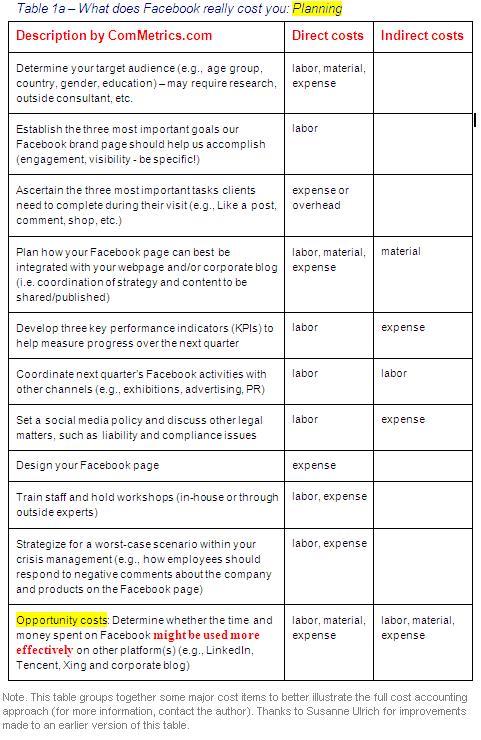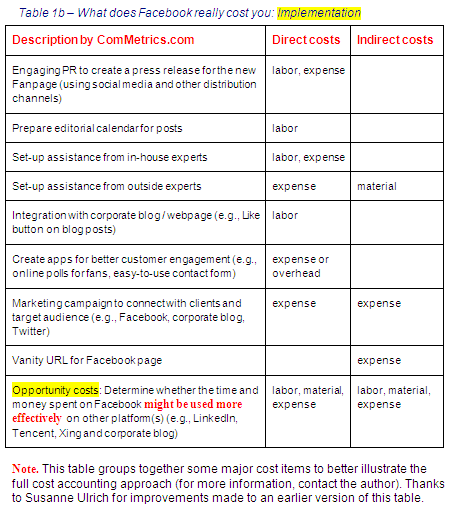Last week we launched the ComMetrics social media cost classification model. This post is the next installment in a series that addresses social media issues arising from increasing links between compensation for service providers and the value they generate for clients (pay-for-performance 2.0) (see also 2011 trends: The social media cost-benefit pyramid).
A recent study of UK e-commerce retailers showed that only 3 percent of website traffic came from social networks. But while search engines and promotional emails drive greater traffic, some retailers like ASOS get more than double that figure from social media. Most of those who ‘Like’ brand and corporate pages (e.g., luxury brands, Starbucks) do so mainly to learn about specials, discounts and updates, etc. As importantly, over 14 percent of employers already block Facebook access at work and that number is growing.
- Article source – 2 tips for smart cost management: Facebook strategy
If users do not wish to engage with you and your product on Facebook, you need to get a better handle on costs to ensure you spend your resources wisely, as discussed below.
- Tip 1: Set a budget – get your strategy right
You may not want to set a precise budget (material, labor, expenses/overhead separated into direct and indirect costs) right away. Nevertheless, streamlining this process is a must and Table 1a will help you achieve this objective by outlining the types of issues that must be addressed before launching a Facebook page.
To support your efforts, expenditures have been grouped into indirect costs (also known collectively as overhead – cannot be attributed directly to a product, service or department), and direct costs. Our previous blog post outlined how each cost type can be attributed to one of three categories – materials, labor and/or expenses or overhead.
However, to do this properly, we must specify the two or three critical tasks we want visitors to perform during their visit. To illustrate, a firm that offers consumers local searches if they need to find a dentist or bookstore may want visitors to conduct a search directly from its Facebook page. By contrast, an engineering firm might want visitors to download their eBook that helps people prepare a tender or another teaser that provides value to the interested Facebook fan.
This indicates that if the critical tasks we want visitors to perform have been identified, we need to set measurable objectives and our progress must then be tracked over time to see if the trend is going in the right direction (e.g., increasing monthly active users and number of comments for each post).
The table below demonstrates that it never hurts to compare effort and resources spent on social media like Facebook to what it would take to prepare for a trade show, an ad in a newspaper and/or publish another corporate magazine. Enumerating any and all potential opportunity costs is practical and therefore very helpful.

Sometimes we expect too much from social media, especially considering how little we demand in the way of performance objectives and success or failure in more traditional advertising, like newspaper or television. For instance, a stock broker running a PR campaign with ads in print media must ask, What are the true benefits of this campaign compared to the true costs? Too often, this question is not answered in sufficient detail.
Why not sign up with your email here – be the first to get the next post in your inbox.
Some categories may also benefit from other groups in the company (i.e. indirect costs – charge overhead). An example is ensuring the social media policy complies with local laws and represents best practice and good governance by checking with the legal department.
2 tips for better cost control on Facebook – get a FREE login
- Tip 2: Implementing a brand page on Facebook
Once the issues in Table 1a have been addressed satisfactorily, focusing direct and indirect costs is required, using the categories listed in Table 1b. Some costs are so immaterial or negligible that it is not feasible to track them, even if they are fully traceable. In this case we may just enter expenses/overhead under indirect costs.

Depending on where your company resides within the social business maturity model, costs will be more or less easily traceable. Accordingly, if this is your tenth Fanpage for one more of the company’s brands, it will be a little easier: you will have learned from past mistakes, and be able to more accurately estimate project numbers.
In some cases you might also be able to piggy-back with, and benefit from, another project, such as using a Facebook URL that is already listed on stationary and print ads (might justify charging indirect costs – overhead).
- Bottom line
Distilling direct and indirect costs can be somewhat tricky early on in the social business maturity model. Nevertheless, keeping track of them is a must to be able to show beneficial links.
In turn, using Facebook or Tencent may be a must for some companies. However, for many – including non-profits – it may not be financially viable or strategically smart to use all of these platforms. Using Tables 1a and 1b will help systematize the decision-making process by studying costs incurred with one choice compared to another.
To illustrate, the Facebook platform may not be the best vehicle for finding those that might be purchasing your fast-speed trains, power plants or architectural services.
Okay, here are the questions I have for you:
- 1. What happened when your company introduced a Facebook fanpage?
2. Did you consider strategic issues early on?
3. How did you address costs before launching?
4. What issue/problem would you like to see discussed further?
Please leave your answers in the comments section, and as always, thanks for being a part of our community!
Pingback: MyComMetrics
Pingback: Urs E. Gattiker
Pingback: By @ShigoCreatives
Pingback: Alltop Social Media
Pingback: Tina Cook
Pingback: Tina Cook
Pingback: Chris Isaac
Pingback: cellcity
Pingback: World Economic Forum
Pingback: CyTRAP
Pingback: apuntesgestion
Pingback: World Economic Forum
Pingback: 2 tips for better cost control on Facebook » 2011 trends, best practice, Beziehungsmarketing, cost accounting, social CRM, social media ROI, social network, KPI, cost-benefit analysis » ComMetrics Uni - social media audit, sCRM - online training